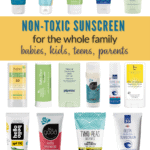The Best Non-Toxic Mineral Sunscreen For The Whole Family 2024
I’m sharing the best non-toxic mineral sunscreen for the whole family. Whether you need mineral sunscreen for a baby, toddler, older kid, teen, or even mom and dad, I’ve found the best non-toxic mineral sunscreen to protect the whole family from sun damage.
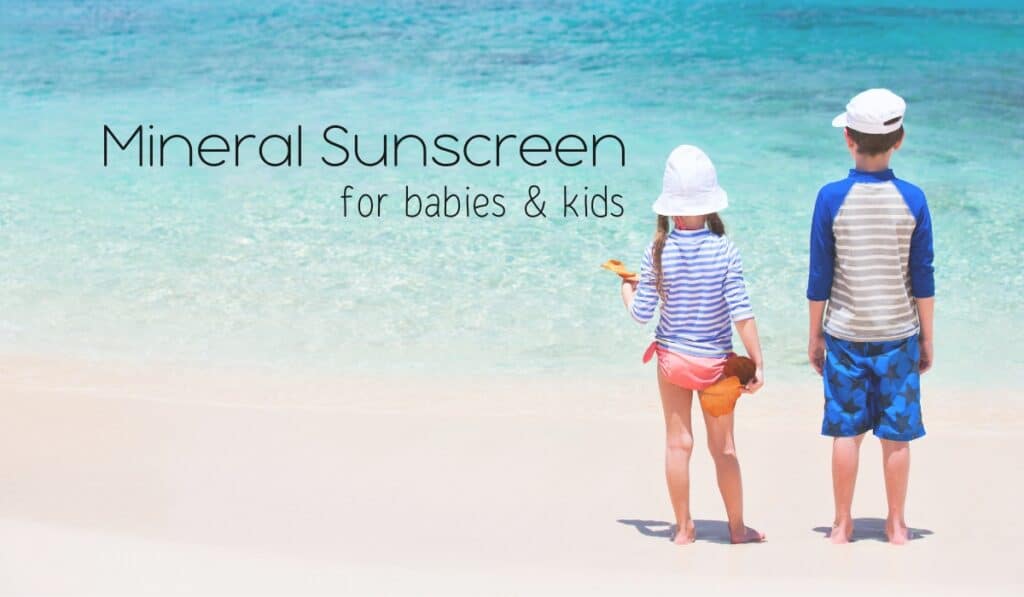
Disclosure: This post contains affiliate links, which means if you make a purchase through these links, we may receive a small commission at no extra cost to you.
Whether your kids are on the soccer field, lounging at the beach, or skateboarding at the park, they need to apply non-toxic mineral sunscreen before they leave the house and reapply every 2 hours. I used the Environmental Working Group Safe Sunscreen Guide and the Switch Natural app as starting points for gathering sunscreen information, although I thoroughly vetted all of the ingredients in each sunscreen myself before they made my list.
Please don’t apply sunscreen to babies under 6 months of age unless you have permission from your pediatrician. Try to keep a hat on your baby’s head to provide some shade, and invest in some UV protective clothing that doubles as swimwear. Keep your baby under a tent or umbrella for extra protection. It’s so important to protect your baby’s skin from damaging UV rays with mineral sunscreen (if they are over 6 months old). My mineral sunscreen picks below are free from ingredients like endocrine disruptors that may cause health issues.
As kids get older, they get pickier about getting sunscreen smeared on their face, and they certainly don’t want to look like a ghost if the sunscreen is too white and doesn’t rub in. I’ve found mineral sunscreen that is made especially for the face. In some cases, maturing teens may be worried about acne, and some of the face formulas are less greasy. Both of my teenagers use Live Tinted Hueguard Mineral Sunscreen SPF30 on a daily basis, and they love that it’s tinted and doesn’t cause breakouts. Find 13 acne-safe non-toxic mineral sunscreen brands here. You’ll also find mineral sunscreen recommendations for the face here.
Some moms that I know have super wiggly kids and asked me to include a few “safer” options, so I’ve included two non-aerosol spray products. Keep in mind that more aerosol spray sunscreens were found to contain the carcinogen benzene than tube sunscreen.
Spray sunscreen can be inhaled, and inhalation of sunscreen particles should be avoided. It’s convenient to use a mineral sunscreen spray, but it’s worth making sure your child isn’t breathing in any particles. I would only use a spray sunscreen on a child that can hold their breath, so it’s a hard no for babies. Spray the sunscreen outside only where there is plenty of ventilation. Have your child hold their breath, spray where needed, and have your child run out of the spray area before taking a breath.
Another option for easier sunscreen application is to use a Solar Buddies Sunscreen Applicator.
If you only apply sunscreen once in the morning, you risk burning your skin and exposing it to dangerous UV rays. No matter how good your sunscreen is, you have to reapply it every 2 hours. Apply at least a shot glass full every time you apply/reapply.
I also recommend avoiding direct sunlight during peak hours (10 a.m. to 2 p.m.). A few other helpful tips: wear a wide-brimmed hat, sunglasses and UV protective clothing, as well as seeking shade.
If you’ve got questions about sunscreen, scroll to the Frequently Asked Questions section at the bottom of the page.
The non-toxic mineral sunscreen recommendations below work perfectly for the whole family. I’ve included recommendations for kids, babies, teens and mom and dad, and anyone that needs sun protection!

Attitude
Attitude Sunscreen
Cost: $15 – $24
Active Ingredient: 20% non-nano zinc oxide
Highlights: Attitude carries an array of sunscreen products, from plastic-free sticks to sunscreen in tubes. I love that they have fragrance-free options as well as sunscreen for sensitive skin. All Attitude sunscreen provides broad spectrum UVA/UVB protection and is EWG VERIFIED™ and dermatologically tested.
For Sensitive Skin: Attitude Kid & Baby Sensitive Mineral Sunscreen SPF30
For Adults: Attitude Mineral Sunscreen SFP30
For Kids & Babies: Attitude Mineral Sunscreen For Babies & Kids SPF30
Stick Sunscreen: Attitude Sensitive Mineral Stick Sunscreen SPF30, Attitude Kid & Baby Mineral Stick Sunscreen SPF30, Attitude Mineral Tinted Stick Sunscreen SPF30
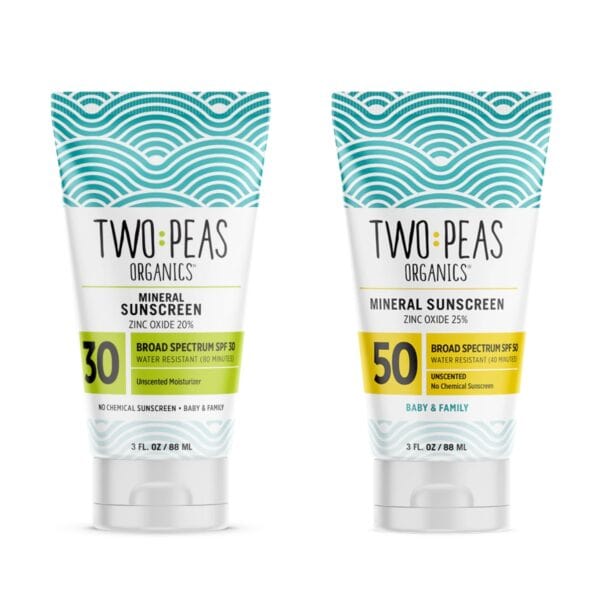
Two Peas Organics
Two Peas Organic Sunscreen
Cost: $14 – $17
Active Ingredient: 20% non-nano zinc oxide
Water Resistant: up to 80 minutes
Highlights: This water resistant unscented sunscreen provides powerful broad spectrum UVA/UVB protection with zinc oxide to help prevent sunburn, skin cancer and premature aging. Made with certified organic coconut oil, jojoba oil and shea butter, this product will leave your skin feeling smooth and protected. No fragrance, PABA, parabens, phthalates, BPA, oxybenzone, avobenzone, petrolatum or 1,4-dioxane. Biodegradable ingredients and reef friendly.
Sunscreen For The Whole Family: Two Peas Organics Mineral Sunscreen SPF30, Two Peas Organics Mineral Sunscreen SPF50
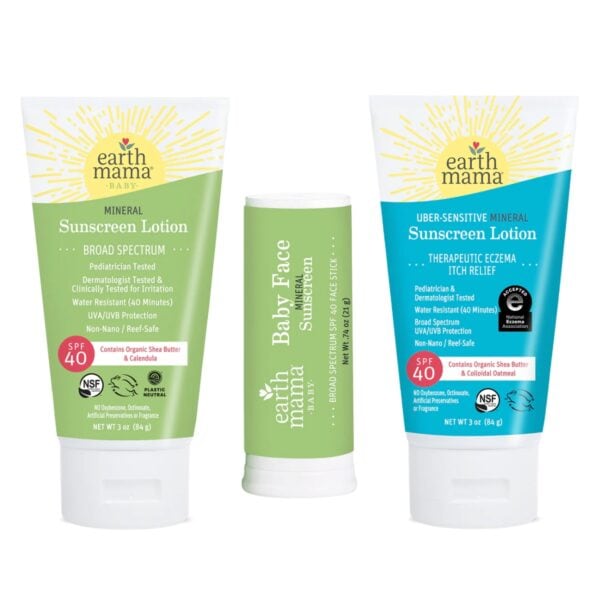
Earth Mama
Earth Mama Sunscreen
Cost: $11 – $18
Active Ingredient: 25% non-nano zinc oxide
Water Resistant: 40 minutes
Highlights: Earth Mama Sunscreen is free from chemicals that are potentially harmful to people and the planet like oxybenzone or octinoxate, artificial fragrance, nano-particles or parabens. This broad spectrum sunscreen offers UVA/UVB protection and is packed with organic ingredients and good-for-the-skin antioxidants.
Sensitive Skin: Earth Mama Uber Sensitive Mineral Sunscreen SPF40
Stick Sunscreen: Earth Mama Baby Mineral Sunscreen Stick SPF40
Tinted Sunscreen: Earth Mama Tinted Mineral Sunscreen SPF40
Sunscreen For The Whole Family: Earth Mama Baby Mineral Sunscreen SPF40
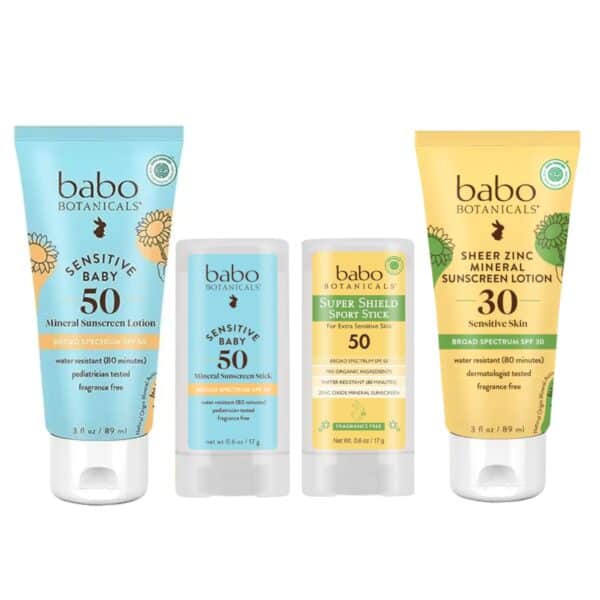
Babo Botanicals
Babo Botanicals Sunscreen
Cost: $13 – $24
Active Ingredient: 16% – 20% non-nano zinc oxide
Water Resistant: up to 80 minutes
Highlights: Babo Botanicals sunscreen protects skin from the sun’s harmful UVA and UVB rays. They carry a wide range of sun protection products, from sunscreen in a tin to face sunscreen to sunscreen for babies and kids. All of their formulas are hydrating and contain plant-based ingredients including sunflower oil and shea butter to moisturize and soothe sensitive skin.
Baby: Babo Botanicals Baby Mineral Sunscreen SPF50
Baby Stick: Babo Botanicals Baby Face Mineral Sunscreen Stick SPF50
Faces: Babo Botanicals Daily Sheer Mineral Sunscreen Fluid SPF50
Spray Sunscreen: Babo Botanicals Mineral Pump Sunscreen Spray SPF30
Sunscreen For The Whole Family: Babo Botanicals Sheer Mineral Sunscreen SPF50
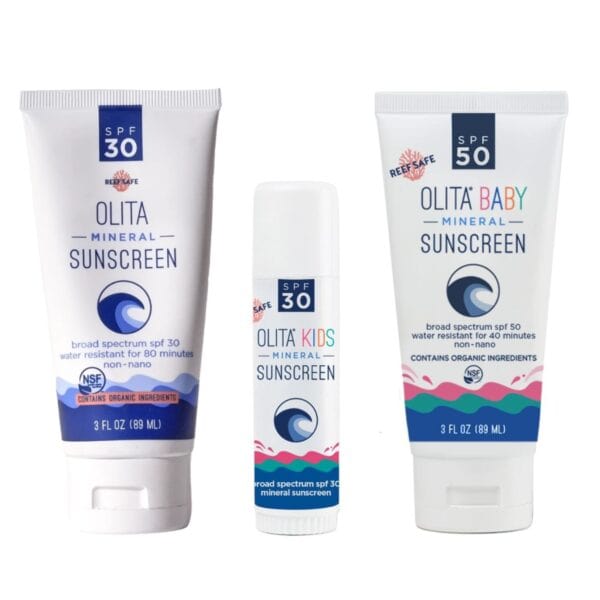
Olita
Olita Sunscreen
Cost: $16 – $20
Active Ingredient: 20% non-nano zinc oxide
Water Resistant: up to 80 minutes
Highlights: Olita sunscreen is gentle on sensitive skin but packs powerful UVA/UVB protection for a day of outdoor adventuring. Made with only clean, organic ingredients, their easily blend-able formula is non-toxic, fragrance-free and water-resistant for up to 80 minutes.
Baby Sunscreen: Olita Baby Mineral Sunscreen SPF50
Stick Sunscreen: Olita Kids Mineral Stick Sunscreen SPF30
Tinted: Olita Tinted Mineral Sunscreen SPF30
Lip Balm: Olita Mineral Lip Balm SPF15
Sunscreen For The Whole Family: Olita Mineral Sunscreen SPF30
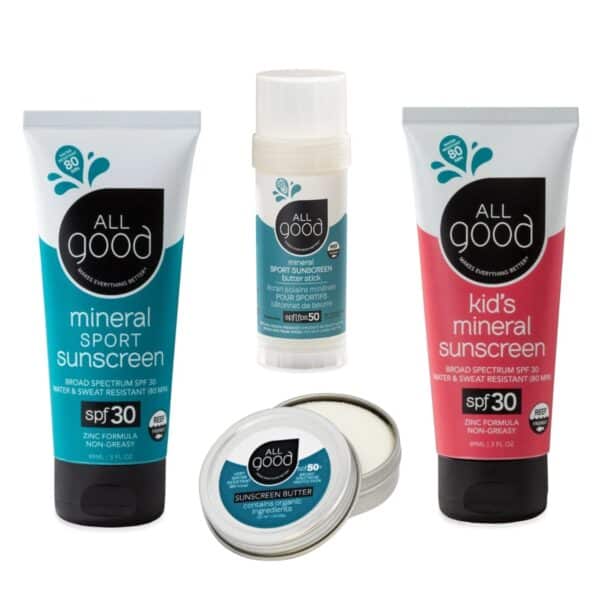
All Good
All Good Sunscreen
Cost: $10 – $30
Active Ingredient: 16% – 25% non-nano zinc oxide
Water Resistant: up to 80 minutes
Highlights: All Good sunscreen not only the basics (broad spectrum UVA/UVB protection and water-resistant), but goes the extra mile with a commitment to reef-friendly ingredients that are lightweight, non-greasy and actually hydrate and repair skin.
Kids Sunscreen: All Good Kids Mineral Sunscreen SPF30
Stick Sunscreen: All Good Kids Mineral Sunscreen Stick SPF50
Sunscreen Tin: All Good Mineral Sunscreen Butter SPF50
Tinted: All Good Tinted Mineral Sunscreen SPF30
Sunscreen For The Whole Family: All Good Mineral Sport Sunscreen SPF30
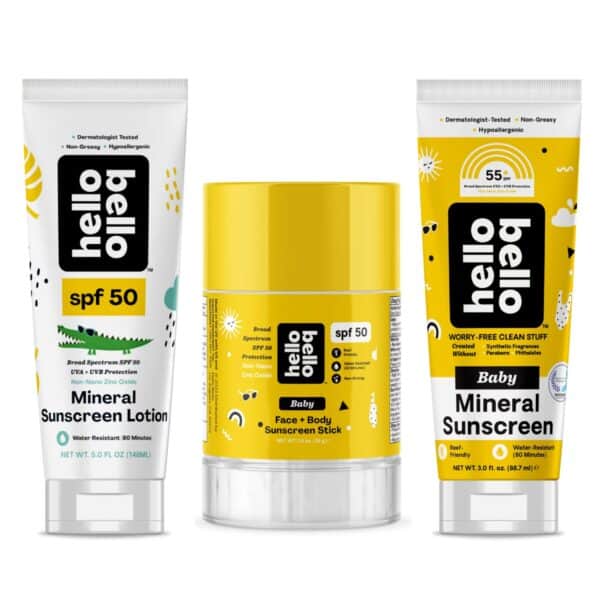
Hello Bello
Hello Bello Sunscreen
Cost: $8 – $20
Active Ingredient: 20% non-nano zinc oxide
Highlights: Hello Bello offers affordable UVA/UVB sun protection for babies and kids, and you won’t find additives like fragrance that irritate sensitive skin.
Baby Sunscreen: Hello Bello Baby Mineral Sunscreen SPF55
Sunscreen For The Whole Family: Hello Bello Mineral Sunscreen SPF50
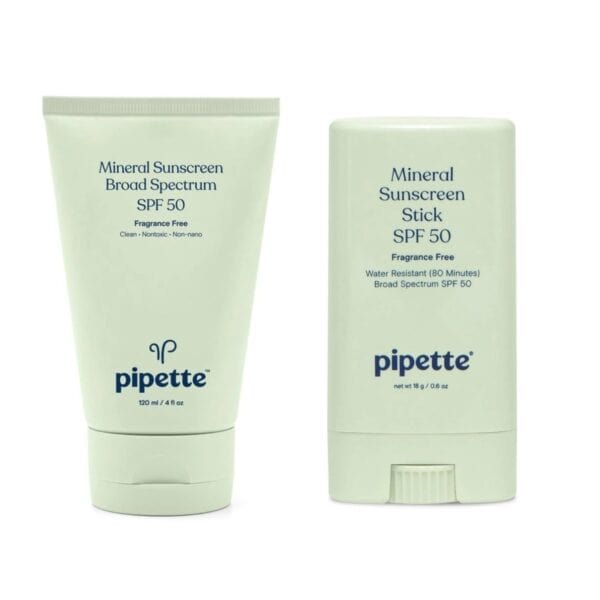
Pipette
Pipette Sunscreen
Cost: $8 – $15
Active Ingredient: 20% – 21% Non-nano zinc oxide
Water Resistant: the stick is water resistant up to 80 minutes
Highlights: Pipette carries a moisturizing, baby-safe mineral SPF that’s also the best sunscreen for kids and the whole family. It’s also non-comedogenic.
Stick Sunscreen: Pipette Mineral Sunscreen Stick SPF50
Sunscreen For The Whole Family: Pipette Mineral Sunscreen SPF50
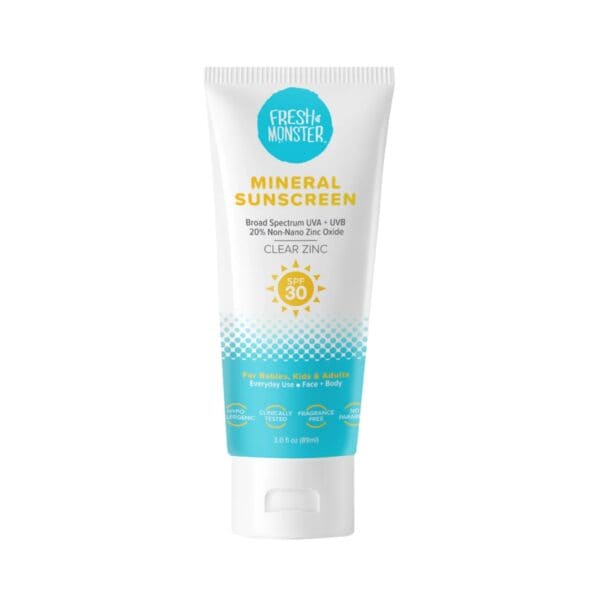
Fresh Monster
Fresh Monster Mineral Sunscreen SPF30
Cost: $16.99 for 3 fl oz ($5.66 per ounce)
Active Ingredient: 20% non-nano zinc oxide
Highlights: This revolutionary, lightweight non-nano zinc Oxide formula melts easily onto skin, providing protection and moisturization without a white cast. This natural formula is hypoallergenic, fragrance free and does not contain any chemical sunscreen filters. Packed with certified organic plant extracts to moisturize and provide anti-oxidant and anti-inflammatory benefits. Toxin-free and safe for sensitive skin.
Sunscreen For The Whole Family: Fresh Monster Mineral Sunscreen SPF30
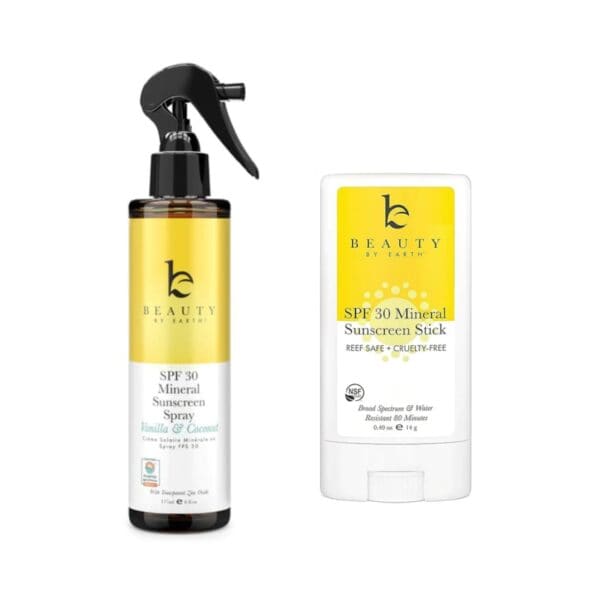
Beauty by Earth
Beauty by Earth Sunscreen
Cost: $16 – $25
Active Ingredient: 20% non-nano zinc oxide
Highlights: Beauty by Earth has sun protection essentials like sunscreen pump spray and a mineral sunscreen stick that protect from harmful UVA/UVB rays and contain high quality ingredients to keep your skin moisturized as well as protected.
Stick Sunscreen: Beauty by Earth Mineral Sunscreen Stick SPF30
Spray Sunscreen: Beauty by Earth Mineral Sunscreen Spray SPF30
Frequently Asked Questions
Is Chemical Sunscreen Safe?
Chemical Sunscreens are absorbed into your skin. They work by converting UV rays into heat and dissipating the heat from your skin. Since chemical sunscreen is absorbed through the skin, it can gain entry into your bloodstream. In a 2020 study on chemical sunscreen ingredients, plasma concentration levels of the active sunscreen ingredients avobenzone, oxybenzone, octocrylene, homosalate, octisalate, and octinoxate were measured in study participants after sunscreen application. The levels of all 6 active sunscreen ingredients exceeded the threshold established by the FDA. Not only were these chemicals present right after application, they remained in the body for extended periods of time (1).
Currently, the FDA recommends further study on the safety and efficacy of the 12 following SPF ingredients: cinoxate, dioxybenzone, ensulizole, homosalate, meradimate, octinoxate, octisalate, octocrylene, padimate O, sulisobenzone, oxybenzone, and avobenzone. Under proposed FDA guidelines, the active ingredients aminobenzoic acid (PABA) and trolamine salicylate would not be considered safe to use.
The active sunscreen ingredients oxybenzone, octinoxate and homosalate are established endocrine disruptors (2, 3). Endocrine disruptors have adverse effects on hormone function and human reproduction (4, 5).
Some ingredients in sunscreen can have deleterious effects on our aquatic ecosystem. In 2018, Hawaii passed legislation that restricts the use of personal care products containing oxybenzone and octinoxate, based on an association between the banned ingredients and damage to coral reefs.
What’s The Best Active Ingredient For Sunscreen?
Physical sunscreen sits on the top layer of your skin, and both absorbs and scatters UV radiation (6). Zinc oxide is one of the most effective sun protectors available, blocking out both short and long wave UVA rays and all UVB rays. Microfine zinc oxide is also photostable and does not degrade when exposed to sunlight (7). Some sunscreen companies use a combination of zinc oxide and titanium dioxide (both minerals). I have an in-depth guide on sunscreen explaining the definition of SPF, active and inactive ingredients to look for in sunscreen, how mineral (physical) sunscreen works, wavelength protection from some popular sunscreen active ingredients, and more.
At this time, the FDA (the Food and Drug Administration of the USA) recognizes Zinc Oxide and Titanium Dioxide as the only safe and effective active ingredients in sunscreen. If you’re concerned about zinc oxide or titanium dioxide entering your bloodstream, scientific studies have demonstrated that these particles do not penetrate beyond the top layer of skin (8, 9).
As a general rule of thumb, physical sunscreen is gentler on the skin than chemical sunscreen, making it a good choice for sensitive skin. It’s also less likely to clog your pores than chemical sunscreen. The National Eczema Association recommends physical sunscreen for people with eczema.
Inactive Ingredients To Avoid
- Fragrance (parfum)– Personal care products can list fragrance as one ingredient and don’t have to disclose the fact that these formulations may contain hundreds of ingredients. Synthetic Fragrance may contain carcinogens, endocrine disruptors, allergens, respiratory irritants and neurotoxic chemicals (10).
- Parabens– Based on a study conducted at the University of California Berkeley, researchers found that parabens were able to stimulate breast cancer cell growth, even at concentrations 100 times lower than the natural growth factor heregulin. These findings suggest that paraben exposure doesn’t have to be high to lead to cancer growth (11).
- Polyethylene Glycol (PEG)– Polyethylene glycol is used to make lotion thicker and better able to transport moisture to the skin. The manufacturing process can introduce impurities and by-products, such as ethylene oxides and 1,4-dioxane, which are known carcinogenic materials (12).
- Phenoxyethanol– Phenoxyethanol is a preservative that both The European Union and Japan restrict above 1% concentration in skincare products. The EU considers phenoxyethanol toxic on the lips and around the mouth. In addition, the French ANSM restricted use of phenoxyethanol as a preservative in products that are applied to the diaper area of babies and kids under 3 years of age (13). With the large amount of sunscreen that needs to be applied and reapplied to children and babies every 2 hours, I recommend choosing a sunscreen that does not contain phenoxyethanol.
More Natural Living Inspiration For Kids
- Everything You’ve Ever Wanted To Know About Sunscreen
- The Best Mineral Sunscreen For Your Face
- Clean, Natural + Non-Toxic Shampoo
- The Best Natural Toothpaste For Kids
- Organic & Natural Lip Balm For Dry Lips
- The Best Clean & Natural Lotion For Dry Skin
- Make The Switch To Natural Dry Shampoo
- Kids Organic Cotton Pajamas
- Non-Toxic Baby Registry
- Safe Floor Cleaner For Babies & Pets
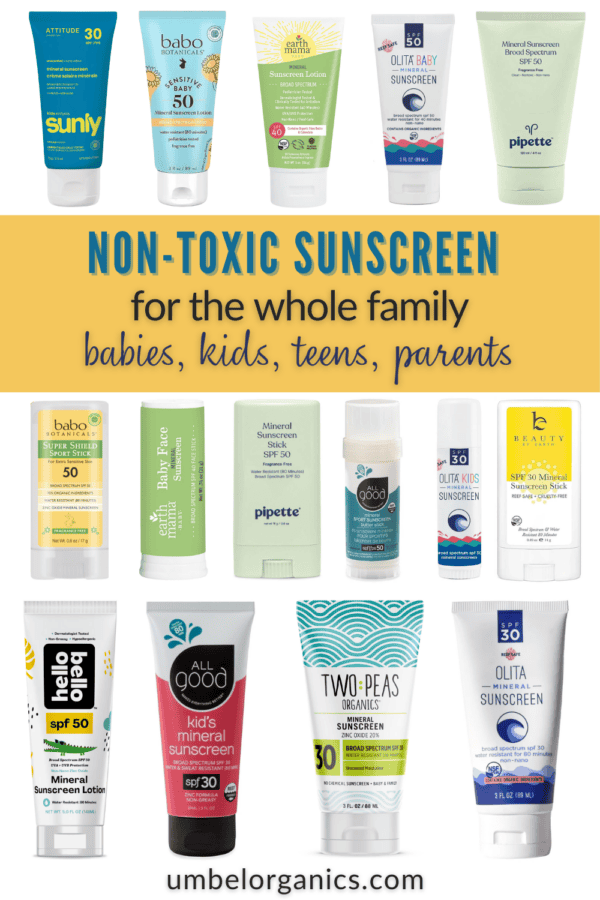
References
- Matta, M.K. et al. Effect of Sunscreen Application on Plasma Concentration of Sunscreen Active Ingredients. A Randomized Clinical Trial. JAMA. 2020;323(3):256-267.
https://jamanetwork.com/journals/jama/article-abstract/2759002?guestAccessKey=81a4a1e1-66d2-4f85-8d80-8d4d1aa1c56e&utm_source=For_The_Media&utm_medium=referral&utm_campaign=ftm_links&utm_content=tfl&utm_term=012120 - Cole, C. et al. Metal oxide sunscreens protect skin by absorption, not by reflection or scattering. Photodermatol Photoimmunol Photomed. 2016 Jan;32(1):5-10. doi: 10.1111/phpp.12214. Epub 2015 Nov 10.
https://www.ncbi.nlm.nih.gov/pubmed/26431814 - Maipais, S. and Nicolopoulou-Stamati, P. Sun lotion chemicals as endocrine disruptors. Hormones, 2015, 14 (1):32-46.
https://www.researchgate.net/publication/275049227_Sun_lotion_chemicals_as_endocrine_disruptors - https://www.ewg.org/sunscreen/report/the-trouble-with-sunscreen-chemicals/
- Bloom et al., Hum Reprod 2015; Buck Louis et al., Fertil Steril 2015. Associations between urinary phthalate concentrations and semen quality parameters in a general population.
https://www.ncbi.nlm.nih.gov/pmc/articles/PMC4605371/ - Life Study
https://www.nichd.nih.gov/about/org/diphr/od/research/longitudinal - Mitchnick, M.A., Fairhurst, D. and S.R. Pinnell. Microfine Zinc Oxide (Z-cote) as a Photostable UVA/UVB Sunblock Agent. J Am Acad Dermatol. 1999 Jan;40(1):85-90.
https://pubmed.ncbi.nlm.nih.gov/9922017/#:~:text=BACKGROUND%3A%20Microfine%20zinc%20oxide%20(Z,(340%2D400%20nm).&text=It%20is%20photostable%20and%20does%20not%20react%20with%20organic%20sunscreens%20under%20irradiation. - Beasley DG, Meyer TA. Characterization of the UVA protection provided by avobenzone, zinc oxide, and titanium dioxide in broad-spectrum sunscreen products. Am J Clin Dermatol. 2010;11(6):413‐421. doi:10.2165/11537050-000000000-00000
https://pubmed.ncbi.nlm.nih.gov/20806994/ - Leite-Silva, V.R. et al. Human skin penetration and local effects of topical nano zinc oxide after occlusion and barrier impairment. Eur J Pharm Biopharm. 2016 Jul;104:140-7. Epub 2016 Apr 27.
https://pubmed.ncbi.nlm.nih.gov/27131753/ - Nudelman, J. and Engel, C. Right To Know. Exposing toxic fragrance chemicals in beauty, personal care and cleaning products. Breast Cancer Prevention Partners and Campaign For Safe Cosmetics. Sept. 2018.
https://d124kohvtzl951.cloudfront.net/wp-content/uploads/2018/09/26092837/BCPP_Right-To-Know-Report_Secret-Toxic-Fragrance-Ingredients_9_26_2018.pdf - Pan S, Yuan C, Tagmount A, Rudel RA, Ackerman JM, Yaswen P, Vulpe CD, Leitman DC. 2016. Parabens and human epidermal growth factor receptor ligand cross-talk in breast cancer cells. Environ Health Perspect 124:563–569; http://dx.doi.org/10.1289/ehp.1409200
https://ehp.niehs.nih.gov/doi/10.1289/ehp.1409200 - Jang, H.J. et al. Safety Evaluation of Polyethylene Glycol (PEG) Compounds for Cosmetic Use. Toxicol Res. 2015 Jun; 31(2): 105–136.
https://www.ncbi.nlm.nih.gov/pmc/articles/PMC4505343/ - Dréno, B., T. Zuberbier, C. Gelmetti, G. Gontijo, M. Marinovich. Safety review of phenoxyethanol when used as a preservative in cosmetics. Journal of The European Academy of Dermatology and Venereology. 07 October 2019: https://doi.org/10.1111/jdv.15944
https://onlinelibrary.wiley.com/doi/full/10.1111/jdv.15944

